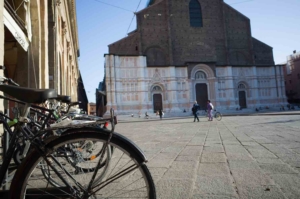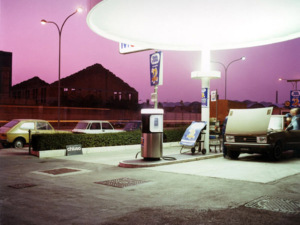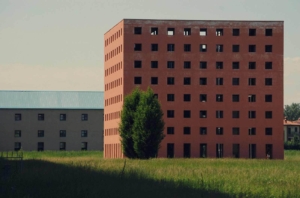Santo Stefano in Bologna: all you have to know to enhance your visit
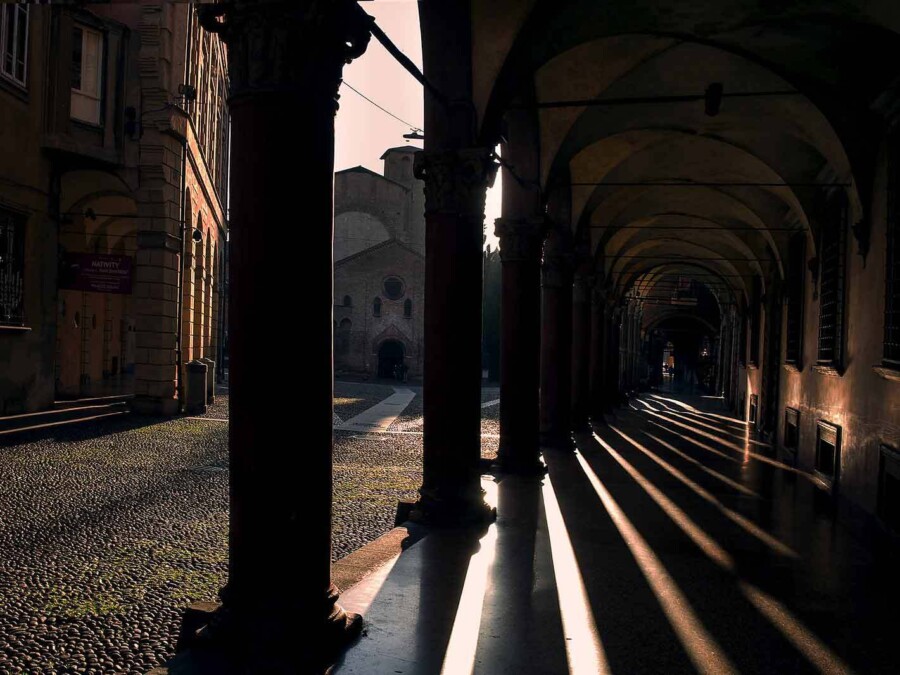
Santo Stefano in Bologna is a century-old Basilica full of symbols and myths.
It's one of the best churches in Bologna and you should put it at the top of your travel list.
It is best known as "Sette Chiese" ("Seven Churches") due to its unique structure, which merges several buildings constructed across different historical periods.
To tell its story, we need to travel from the Holy Land to Dante's hell, meeting relics, roosters and Magi.
So sit down and relax: the gate is opening.
1. From Jerusalem to Bologna: La Chiesa del Santo Sepolcro
You can't read about Santo Stefano Basilica if you don't know about San Petronio.
He's one of the patron saints of Bologna, the most important and celebrated one.
Did you see the magnificent San Petronio Basilica?
It's dedicated to him.
So San Petronio.
On Oct. 4th, 1141 his remains were found inside the Basilica of Santo Stefano. Just a coincidence?
Legend tells that bishop Petronio, after a trip to the Holy Land, founded the 7 churches complex to reproduce the places of worship in Jerusalem.
Need proofs and data?
Not much, but symbols as you want.
The Chiesa del Santo Sepolcro, the second you will visit after entering, would reproduce the tomb of Christ on the model of the tomb of the Anastasis in Jerusalem.
The external structure of the church has 8 sides, like the day of the resurrection.
The internal one has 12, like the number of the apostles and the tribes of Israel.
There are also 12 columns surrounding the tomb, 7 of which are in Egyptian cipolin marble.
But there is another one that deserves your attention.
See the black column?
It's made of marble from Africa. It represents the passion of Christ, in particular of the column of the flagellation.
In the past, it was believed to provide 200 years of indulgence to those who visited the Basilica.
San Petronio's relics were kept inside Chiesa del Sepolcro until 2000, then moved inside his Basilica in Piazza Maggiore.
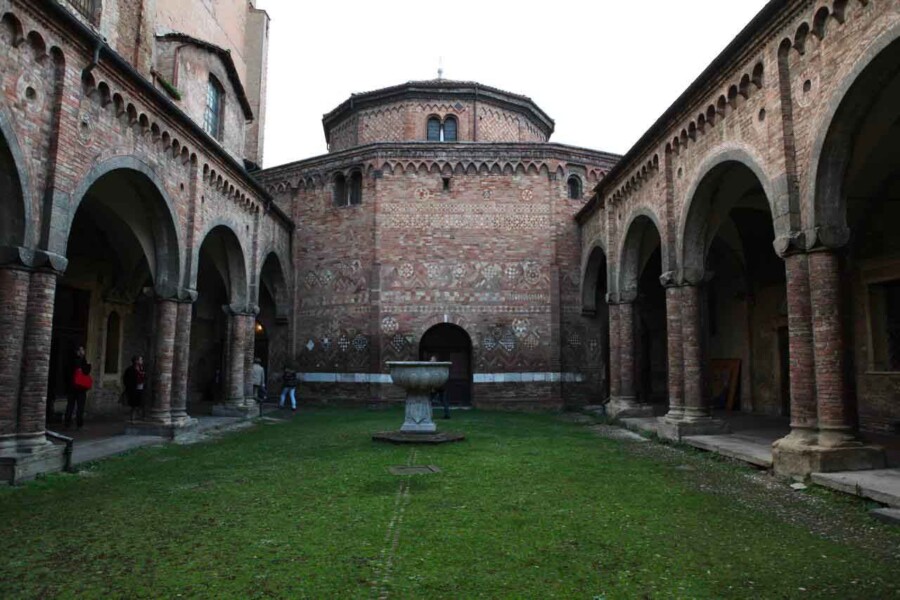
Pilato's courtyard
2. The olive mountain: Basilica of San Giovanni in Monte
But Petronio didn't stop there.
A few steps from Santo Stefano he had built a hill and placed a cross with 12 columns on it.
He called it Monte Oliveto (olive mountain), on what would later become the Basilica of San Giovanni in Monte.
The space between the 2 Basilicas was called the "Valley of Giosafat", due to the traditions and liturgies celebrated there. In the past, it contained a church dedicated to Santa Tecla.
San Giovanni in Monte was supposed to have a circular plan with an altar and a cross in the center.
Only the altar has been preserved from the ancient Basilica and you can see it in the central nave.
The Church preserves a fragment of the arm of San Petronio to testify the strong bond with him.
3. Supported by faith: Chiesa del Crocifisso and the Crypt of Santo Stefano
The first church you see at the entrance is the Chiesa del Crocifisso.
A few steps lead to its crypt.
What is the crypt of Santo Stefano?
Constructed in the 11th century, it served as a place of prayer for Benedictine monks.
The crypt features five naves supported by 14 unique columns, each differing in materials and design.
Notably, one column is said to represent the height of Jesus Christ at his death, measuring approximately 1.70 meters
Adjacent to the altar, the remains of Saints Vitale and Agricola are preserved in two urns.
The crypt also houses 15th and 16th-century frescoes, adding to its historical and artistic significance.
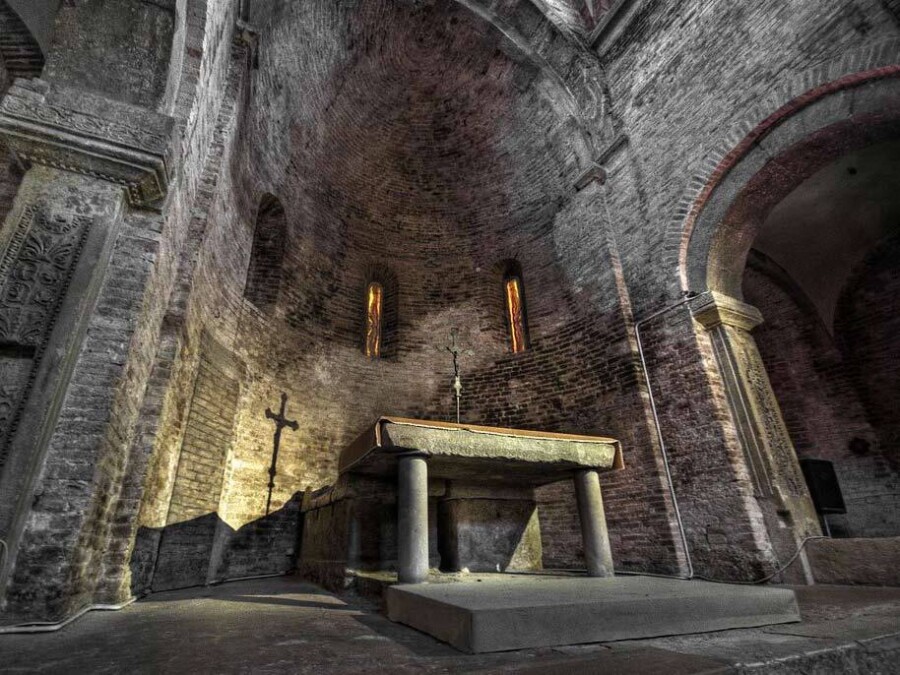
The altar of Chiesa dei Santi Vitale and Agricola
4. Silent in the shadows: Chiesa dei Santi Vitale and Agricola
Chiesa dei Santi Vitale and Agricola is the simplest church of Santo Stefano Basilica. But also the one that keeps the vibe of a bygone era.
The silence surrounds it and a suggestive harmony of the architectural forms distinguishes it from the others.
Little warm light filters through the alabaster windows.
You can see remains of mosaics, capitals and fragments of Romanesque-Lombard frescoes.
But who were Vitale and Agricola?
The first was a servant, the other his master. They were martyrs who died together for the faith and were buried inside the Basilica.
Their relics are also found in the monastery of Buonafuente del Sisal in Spain and in the Cathedral of Tours in France, probably granted by San Petronio himself.
The large metal cross fixed to the wall, according to legend, is that of Agricola's crucifixion.
Now let's go back to Chiesa del Sepolcro to get some light and air.
5. Scissors, roosters and stars: Pilate's courtyard
It's the fulcrum of the complex and the richest in symbols.
Take a look at the tombstones under the portico.
One of them shows a pair of scissors and is to be attributed to an unknown tailor, as there is no name.
A little further on is the statue of a rooster, remember the episode of St Peter's denial?
But what is striking about this courtyard are the decorations on the wall of the Chiesa of Santo Sepolcro.
Small fragments of colored brick and splinters of marble. 6, 7, and 8-pointed stars that recall imperfection, completeness,s and resurrection.
In the middle of the courtyard stands Pilate's basin: a reminder of the Lombard in Bologna.
It's a marble basin placed on a pedestal with the symbol of Cardinal Giovanni dei Medici.
It was originally located in the church of San Giovanni Battista to collect the offerings of the faithful.
It is believed to represent the moment when Pilate washed his hands, relieving himself of the responsibility of condemning Jesus Christ and leaving his fate in the hands of his accusers.
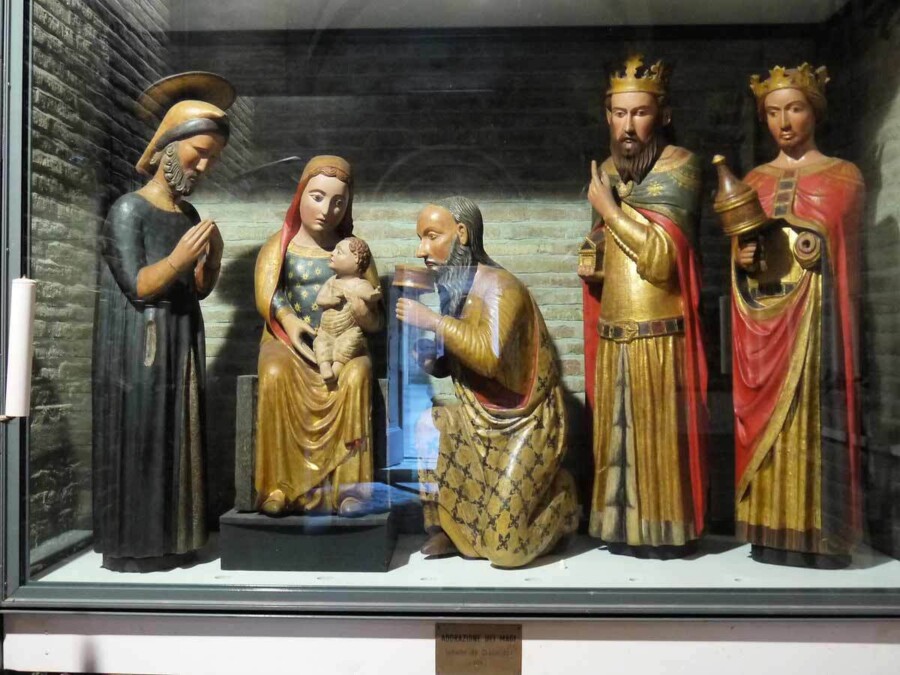
The wood nativity scene in Chiesa della Trinità
6. Ok, but where are the 7 churches? La Chiesa della Trinità
Good question.
There are actually 4 churches today, because of the restoration works in 1880 that changed the shape of the whole complex.
Chiesa della Trinità, which you access from Pilate's Courtyard, is the most difficult to imagine.
The monks in their writings remember it as one of the most important of the complex. But it is difficult to find the sacredness and character of the ancient church.
Destroyed, rebuilt, robbed of the treasures it kept, it was very different from what it looks like today.
But still, there's a gem.
Look at the impressive group of human-sized wooden statues depicting the adoration of the Magi.
It is the oldest known nativity scene in the world made up of round statues.
The work was first sculpted from lime and elm trunks by an anonymous Bolognese sculptor. Only later in 1370 the Bolognese painter Simone dei Crocefissi coloured it.
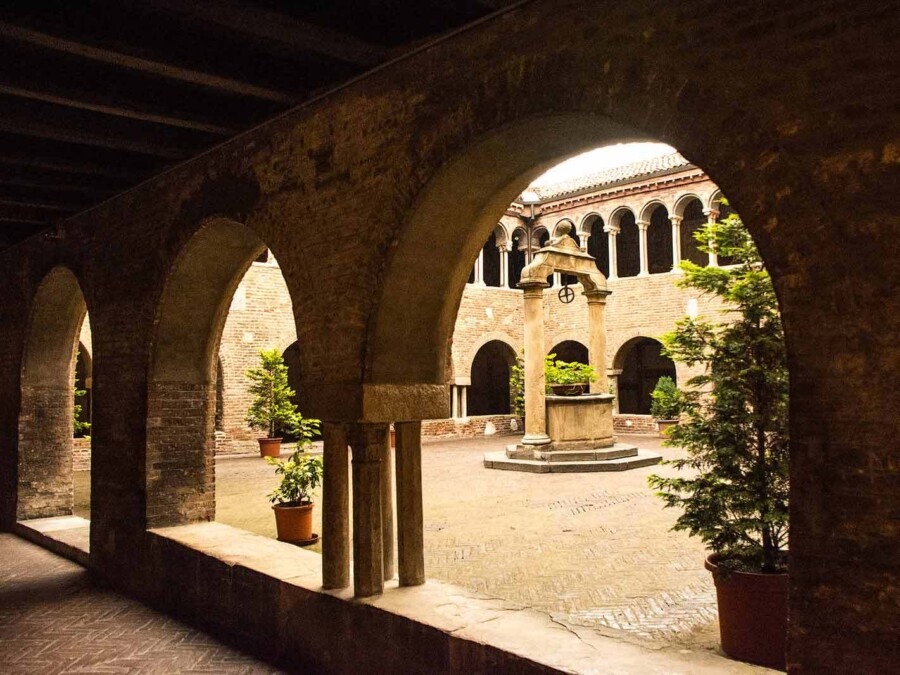
Santo Stefano monastery and its cloister
7. From the hell of Dante: The Monastery and its cloister
The last stop of your visit is the monastery of Santo Stefano and its cloister. Far from the topography of the holy Jerusalem, these are silent and enchanting places.
Even Dante, the poet of the Divine Comedy, passing through Bologna may have been struck by it.
This comes from 2 anthropomorphic capitals you can see in the second order of columns.
One represents a man oppressed by the weight of the arch and the roof, which refers to the punishment of the proud and damned (10th Canto of Purgatory).
While the capital that describes the punishment of the soothsayers seems to correspond to that described by Dante in canto 20 of the hell.
Practical Info
When you visit Basilica di Santo Stefano and all the churches in Italy there is a dress code to follow. It's recommended to take off your hat and cover your shoulders and knees. Sandals and jeans are fine.
Basilica di Santo Stefano
Via Santo Stefano, 24, 40125 Bologna BO
Tel. +39 0514983423
Opening hours:
Tuesday to Sunday, 9:30 am - 12:30 pm, 2:30 pm - 6 pm
Free entrance
Sources: In viaggio verso la Terrasanta. La Basilica di Santo Stefano in Bologna. di Beatrice Borghi, Minerva 2010.
Photo credits: Scott Dickey, Enricodot, Edenpictures @Creative Commons, Holly Hayes @Creative Commons, Arrigo Ceramista
